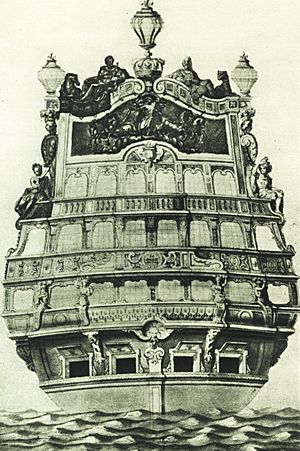Stern facts for kids
The stern is simply the back part of any ship or boat. Think of it as the tail end of a vessel.
The stern has always been important because it's where the steering equipment is located. This includes things like the rudder, which helps steer the ship, or the ship's wheel. Because of this, the stern often became the area for the ship's captain and other important officers.
During the time of sailing ships, the stern was often the fanciest part of the ship. It had many windows, balconies, and beautiful decorations. This made it look grand, but it also made it a weak spot during battles. Enemy ships would try to line up to fire all their cannons directly into the stern, which was called a stern rake.
Other things you might find at the stern include lanterns for light and the ship's ensign, which is a special flag showing its nationality.
Contents
What is a Ship's Stern?
The stern is the very back section of a boat or ship. It's the opposite of the bow, which is the front. Every vessel, from a small rowboat to a huge ocean liner, has a stern.
Why is the Stern Important for Ships?
The stern holds many key parts that help a ship move and steer. This area is where the engine's propeller is usually found, pushing the ship forward. It's also where the rudder is attached, which helps the captain steer the ship left or right.
The Captain's Place: Stern History
Historically, the stern was a very important area. It was close to the steering gear, so the captain and officers often had their living quarters there. On old sailing ships, the stern was often decorated with fancy carvings and windows. This showed how important the ship was.
Sterns in Battle: A Weak Spot
Even though the stern was grand, it was also a vulnerable spot in naval battles. If an enemy ship could get into a position to fire its cannons straight into the stern, it could cause a lot of damage. This was because the stern usually had less armor than the sides of the ship.
Related pages
Images for kids
-
Stern of a Ticonderoga-class guided missile cruiser Mobile Bay
-
The stern of the cargo ship Sichem Princess Marie-Chantal
-
1. Keel (light peach) 2. Skeg (dark purple) 3. Deadwood (olive drab) 4. Stern post (forest green) 5. Filling chock (bright yellow) 6. Filling transoms (pale yellow-green) 7. Wing transom (turquoise) 8. Helm port (orange) 9. Counter timbers (pale violet) 10. Margin (indigo) 11. Horn timber (green) 12. Stern timbers (apricot) 13. Side-counter timbers (pale yellow) 14. Quarter-timbers (red) 15. Fashion timber (fuchsia) 16. Cant frames (blue) 17. Square body frames (uncolored)
-
The stern of the Dutch East India Company ship Amsterdam (transom stern)
-
The stern of a modern sailboat (Tirion28)
See also
 In Spanish: Popa para niños
In Spanish: Popa para niños













